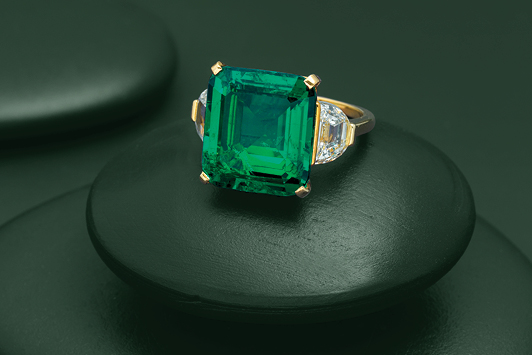
Even during Covid-19, the pre-owned market for high-value gems has remained rock-solid, and emerald is among the rocks that have held their value.
“Twenty years ago, colorless diamonds were king at auction, but buyers today have shifted their attention toward seeking out top-quality colored gems, including extraordinary emeralds,” says Caroline Morrissey, director of jewelry for Bonhams New York. “In 2017, the world record price per carat for an emerald exceeded that of a colorless diamond, and that represents a big shift.”
The gem in question was the 18.04-carat Rockefeller emerald, which sold to Harry Winston at a 2017 Christie’s auction for $5.5 million — a per-carat price of $305,516. In contrast, the record-holder for most expensive individual colorless diamond at auction is the 76.02-carat Archduke Joseph, which sold at a 2012 Christie’s auction for $21.5 million, or $282,485 per carat, according to British luxury consultancy Knight Frank. “Colored gemstones continue to outperform the wider jewelry market,” it concluded in its 2019 Luxury Investment Index.
All the big names
Christie’s saw a decline in the demand for emeralds during the late 1990s, says Daphne Lingon, head of jewelry for Christie’s Americas, but in recent years, “that has changed significantly.” Aside from the Rockefeller-Winston emerald, as the stone is now named, she cites the emerald and diamond pieces from the collection of Elizabeth Taylor, which sold in 2011 in “one of the most important emerald moments at auction in the past 20 years.” Pieces included two outstanding emerald rings — one selling for $6.6 million, or $280,413 per carat, and the other for $3.3 million, or $182,393 per carat.
Emeralds in antique jewels with aristocratic provenance are in high demand, according to Marie-Beatrice Morin, head of PR for the luxury division at Sotheby’s. She references an emerald and diamond parure from circa 1770 that recently sold for nearly $1.1 million. Featuring 14 Colombian emeralds, the necklace was from the collection of the Marquis de Guirior.
Signed jewels also remain strong. “Harry Winston and Bulgari are two of the standouts, in my opinion,” comments Lingon.
Morrissey cites the same two maisons, as well as Van Cleef & Arpels and Cartier. Smaller, exclusive jewelers can also top the charts, she adds, including Hennell, “a British jeweler on par with Cartier.” Among the Hennell pieces Bonhams has sold is a necklace with a Colombian emerald — likely taken from an earlier Mughal jewel — that fetched nearly $1.9 million.
The African angle
Gem origin, however, is the reigning value factor. “Top-quality emeralds of Colombian origin cause bidders from around the world to engage in fierce competition,” says Morrissey. “Gems from other origins are gaining ground, [with] beautiful emerald specimens being found in Africa — Zambia and Mozambique.”
Miner Gemfields has held 41 auctions since 2009, according to the Knight Frank report — 30 for Zambian emeralds and 11 for Mozambican rubies, worth more than $1 billion in combined auction revenue. But can the Zambian specimens fetch the same prices as Colombian?
“The market is still much stronger for emeralds of Colombian origin,” says Morin. “Therefore, we tend not to have many examples of other origins [among] our sales” at Sotheby’s.
Morrissey affirms that the Zambian emeralds are available at “a much more affordable price point.”
Christie’s has “seen an increase in demand for emeralds from regions like Zambia, and I hope that will continue,” says Lingon. However, she adds, “gem-quality emeralds from Colombia, like Burma rubies, remain the gold standard among collectors globally.”
Ultimately, the choice is “really personal,” says Sara Payne Thomeier, head of jewels for the Americas at Phillips. “Some of the new geographical locations produce gem-quality emeralds, but the hue of the green varies from place to place. Emeralds from Colombia are vivid green. Those found elsewhere almost always appear in igneous rocks and have a slightly bluish hue.”
Far-reaching appeal
As for buyers, they are scattered around the globe, partly due to the ease of online bidding and livestreaming. Instead of dampening the auction market, Covid-19 has had the effect of increasing online participation, introducing a new audience to the auction experience.
“In an increasingly global market, buyers have become accustomed to purchasing based on video and images if they cannot preview in person,” says Morrissey.
Certain regions show greater interest in emeralds than others do. “While there is a strong demand for emeralds worldwide, some areas have specifically strong associations with the stone, including India and most of East Asia,” reports Payne Thomeier.
Can emeralds’ importance strengthen in Western minds as well? For now, it is likely to remain an exotic alternative to diamonds as a gift of love. In the meantime, these green treasures are holding their own on the auction market.
Article from the Rapaport Magazine - August 2021. To subscribe click here.